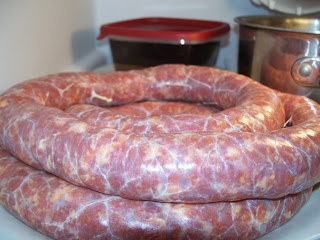I don't know how the simple cannoli clawed its way all the way into my heart. But there it lives, content in the knowledge that it has displaced any patisserie's offering.
When I worked at the Juvenile Court on Roosevelt, we were very near to Taylor and the Ferrara Bakery. At the time they were the best cannoli in the city. After I won my first felony trial I bought a box for the office to celebrate. It was great.
I went back recently to relive the glory days and was sadly disappointed. Maybe it was just a fluke in that particular batch but the cannoli shells tasted like a churro. They had 6x the amount of cinnamon I was expecting. Now I don't have anything against churros but when I want a churro I buy a churro and when I want a cannoli I buy a cannoli. Plus they added peanuts on the outside... cannoli fail.
So I figured it can't be that hard to make them right? ... well... ...uh... ...kinda true.
Quick lessons to keep in mind whenever you're planning to cook. Don't try out your new recipe for the first time when you have company over or you are expected to bring the dish for company. Make it for yourself. Iron out the flaws and get comfortable with the dish. Then, once you've mastered it you can impress company with it. I know this. I recommend this to everyone. However, I often fail to live by this. I just get a bit overly excited... Sorry to everyone who has had to eat watery ricotta or had to wait as I fried cannoli shells like a madman in the other room. Next time, it will be perfect!

Ok so it goes! Scratch made cannoli, inside and out. I have found and mastered the dough, the filling, everything. And the shells do keep, so if you want you can make a batch, freeze them, and then just make the filling fresh. It actually is rather convenient.
Shells...
http://allrecipes.com/Recipe/cannoli-2/Detail.aspxThis recipe from
Lydia Nacawa is absolutely fantastic. She calls for Marsala wine which I never have in the house. I have substituted with white whine and brandy, which we randomly do have in stock. It adds a wonderful, complex and interesting flavor to the dough that pulls it out of churro land and into my heart. This would also go easier with more than three tubes.
- Shells:
- 3 cups all-purpose flour
- 1/4 cup white sugar
- 1/4 teaspoon ground cinnamon
- 3 tablespoons shortening
- 1 egg
- 1 egg yolk
- 1/2 cup sweet Marsala wine
- 1 tablespoon distilled white vinegar
- 2 tablespoons water
- 1 egg white
- 1 quart oil for frying, or as needed
- Filling:
- 1 (32 ounce) container ricotta cheese
- 1/2 cup confectioners' sugar
- 1 cup chopped candied citron
- 4 ounces semisweet chocolate, chopped (optional)
Directions
- In a medium bowl, mix together the flour, sugar and cinnamon. Cut in the shortening until it is in pieces no larger than peas. Make a well in the center, and pour in the egg, egg yolk, Marsala wine, vinegar and water. Mix with a fork until the dough becomes stiff, then finish it by hand, kneading on a clean surface. Add a bit more water if needed to incorporate all of the dry ingredients. Knead for about 10 minutes, then cover and refrigerate for 1 to 2 hours.
- Divide the cannoli dough into thirds, and flatten each one just enough to get through the pasta machine. Roll the dough through successively thinner settings until you have reached the thinnest setting. Dust lightly with flour if necessary. Place the sheet of dough on a lightly floured surface. Using a form or large glass or bowl, cut out 4 to 5 inch circles. Dust the circles with a light coating of flour. This will help you later in removing the shells from the tubes. Roll dough around cannoli tubes, sealing the edge with a bit of egg white.
- Heat the oil to 375 degrees F (190 degrees C) in a deep-fryer or deep heavy skillet. Fry shells on the tubes a few at a time for 2 to 3 minutes, until golden. Use tongs to turn as needed. Carefully remove using the tongs, and place on a cooling rack set over paper towels. Cool just long enough that you can handle the tubes, then carefully twist the tube to remove the shell. Using a tea towel may help you get a better grip. Wash or wipe off the tubes, and use them for more shells. Cooled shells can be placed in an airtight container and kept for up to 2 months. You should only fill them immediately or up to 1 hours before serving.
- To make the filling, stir together the ricotta cheese and confectioners' sugar using a spoon. Fold in the chopped citron and chocolate. Use a pastry bag to pipe into shells, filling from the center to one end, then doing the same from the other side. Dust with additional confectioners' sugar and grated chocolate for garnish when serving.
As for the filling...
Who knew homemade ricotta was so easy?! Well
serious eats ran blogpost on it that caught my eye. They recommend the microwave. However, I'm often trying to make a large amount of ricotta and 10 cups of milk in the microwave seems a bit too much. Besides, I find the stove top method to work just great.
Recipe works like this.
1 Cup Milk (Goat's Milk, 2% Cow, Whole, etc)
1 Tablespoon Acid (Vinegar, Buttermilk, Lemon Juice)
Scale recipe up from here.
Place milk on stove with medium heat. You want to heat the milk evenly and slowly just until it starts to bubble. Stir well and then add acid. Stir in acid very gently, just enough to mix thoroughly. Usually one full sweep around the pot is sufficient for me. Milk should begin to curdle immediately once you've added the acid.
Pour entire mixture over a colander lined with paper towels or cheesecloth. And allow to drain for the amount of time necessary for the desired consistency. For cannoli filling I have been doing about 20 minutes but the density of your paper towels/cheesecloth with affect this time.
Place cheese in fridge until cool. Then, mix cheese with powdered sugar and any other additions (citron, citrus peel, chocolate chips) and stuff in cannoli. Then you may stuff in your face! Enjoy!




























